Directed Evolution of a Glutathione Transferase for the Development of a Biosensor for Alachlor Determination
Abstract
1. Introduction
2. Materials and Methods
2.1. Materials
2.2. Methods
2.2.1. Library Construction
Expression, Purification, and Screening of the Wild-Type and Mutant Enzymes
2.2.2. Assay of Enzyme Activity and Kinetic Analysis
2.2.3. Molecular Modeling
2.2.4. Immobilization of Enzyme and Assessment of Enzyme Activity
2.2.5. Stability Analysis of the Free and Immobilized Enzyme
2.2.6. Colorimetric Assays for the GST-Catalyzed Alachlor Conjugation Reaction
2.2.7. Determination of Alachlor in Natural Water Samples
3. Results and Discussion
3.1. Screening of GmGSTUs Library for Identifying a Shuffled Enzyme for the Development of a Biosensor for Alachlor Determination
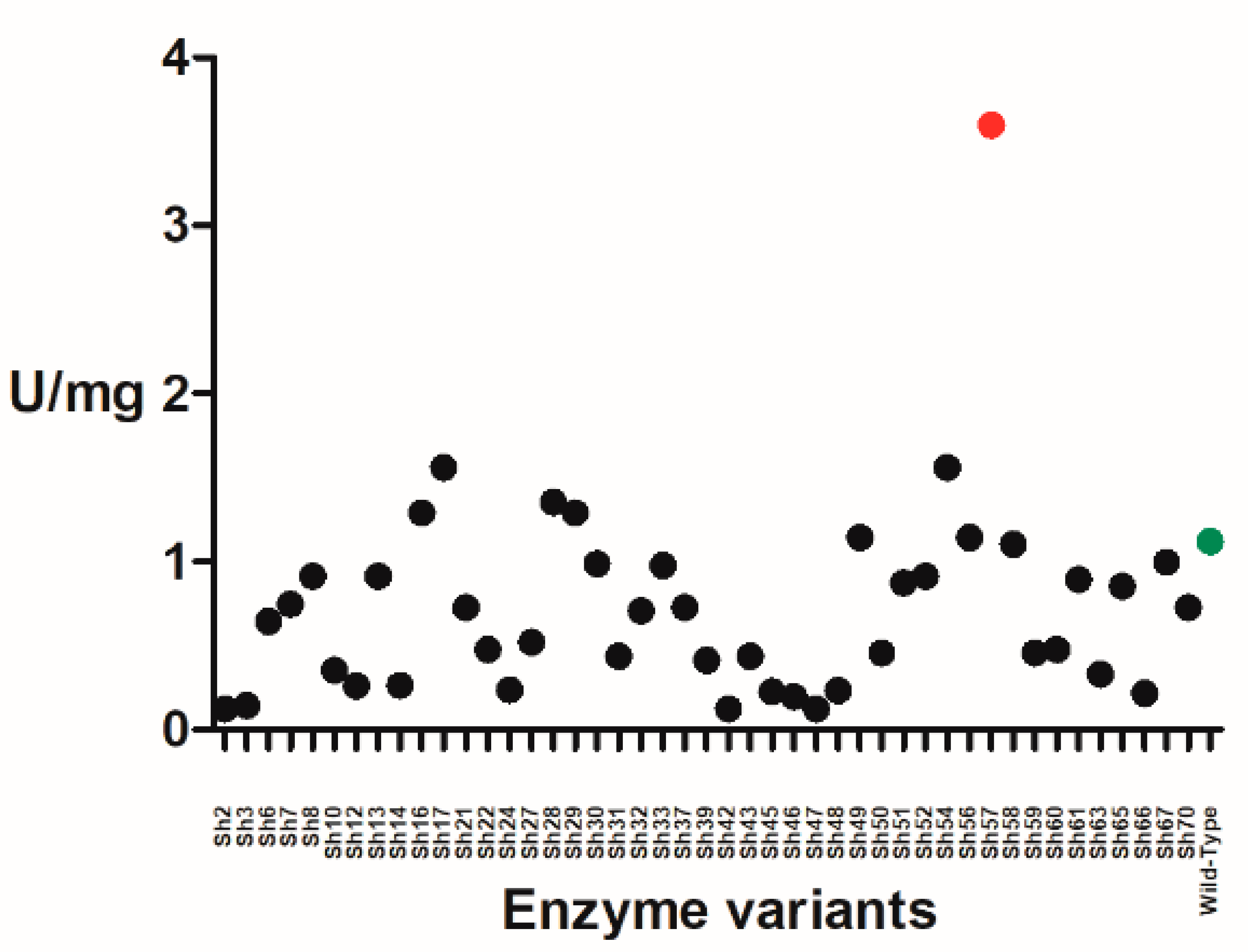
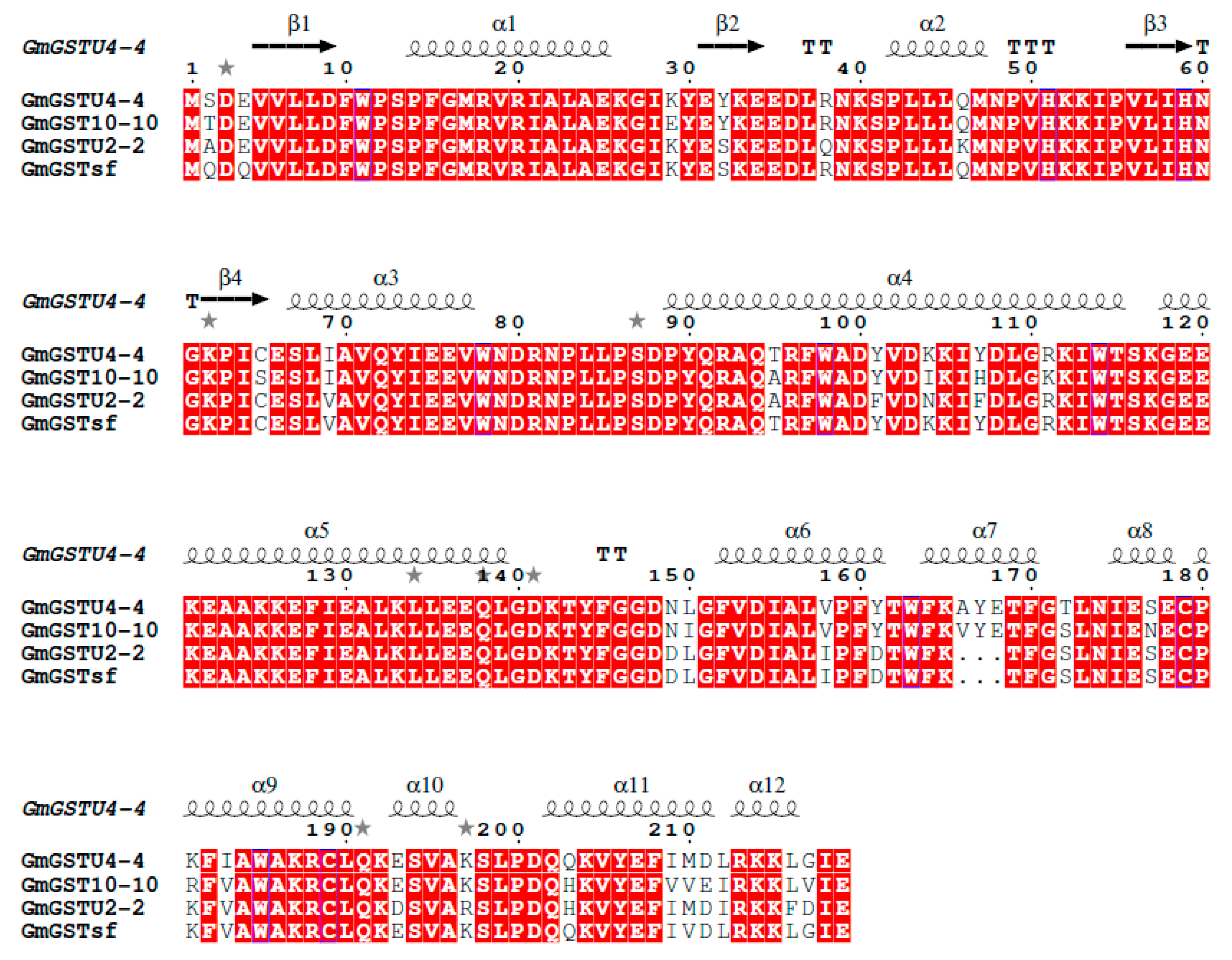
3.2. Molecular Modeling
3.3. Enzyme Immobilization
3.4. Thermal Stability of the Immobilized Enzyme
3.5. The Basis of an Optometric Biosensor for Alachlor Determination
4. Conclusions
Author Contributions
Funding
Institutional Review Board Statement
Informed Consent Statement
Data Availability Statement
Acknowledgments
Conflicts of Interest
References
- Allocati, N.; Masulli, M.; Di Ilio, C.; Federici, L. Glutathione transferases: Substrates, inihibitors and pro-drugs in cancer and neurodegenerative diseases. Oncogenesis 2018, 7, 1–15. [Google Scholar] [CrossRef]
- Mihaljević, I.; Bašica, B.; Maraković, N.; Kovačević, R.; Smital, T. Interaction of organotin compounds with three major glutathione S-transferases in zebrafish. Toxicol. In Vitro 2020, 62, 104713. [Google Scholar] [CrossRef] [PubMed]
- Labrou, N.E.; Papageorgiou, A.C.; Pavli, O.; Flemetakis, E. Plant GSTome: Structure and functional role in xenome network and plant stress response. Curr. Opin. Biotechnol. 2015, 32, 186–194. [Google Scholar] [CrossRef]
- Cummins, I.; Dixon, D.P.; Freitag-Pohl, S.; Skipsey, M.; Edwards, R. Multiple roles for plant glutathione transferases in xenobiotic detoxification. Drug Metab. Rev. 2011, 43, 266–280. [Google Scholar] [CrossRef] [PubMed]
- Nianiou-Obeidat, I.; Madesis, P.; Kissoudis, C.; Voulgari, G.; Chronopoulou, E.; Tsaftaris, A.; Labrou, N.E. Plant glutathione transferase-mediated stress tolerance: Functions and biotechnological applications. Plant Cell Rep. 2017, 36, 791–805. [Google Scholar] [CrossRef] [PubMed]
- Gullner, G.; Komives, T.; Király, L.; Schröder, P. Glutathione S-Transferase Enzymes in Plant-Pathogen Interactions. Front. Plant Sci. 2018, 9, 1836. [Google Scholar] [CrossRef]
- Gallé, A.; Czékus, Z.; Bela, K.; Horváth, E.; Ördög, A.; Csiszár, J.; Poór, P. Plant Glutathione Transferases and Light. Front. Plant Sci. 2019, 9. [Google Scholar] [CrossRef]
- Stavridou, E.; Michailidis, M.; Gedeon, S.; Ioakeim, A.; Kostas, S.; Chronopoulou, E.; Labrou, N.E.; Edwards, R.; Day, A.; Nianiou-Obeidat, I.; et al. Tolerance of Transplastomic Tobacco Plants Overexpressing a Theta Class Glutathione Transferase to Abiotic and Oxidative Stresses. Front. Plant Sci. 2019, 9, 1861. [Google Scholar] [CrossRef] [PubMed]
- Dixon, D.P.; Edwards, R. Protein-Ligand Fishing in planta for Biologically Active Natural Products Using Glutathione Transferases. Front. Plant Sci. 2018, 9, 1659. [Google Scholar] [CrossRef]
- Chronopoulou, E.; Kontouri, K.; Chantzikonstantinou, M.; Pouliou, F.; Perperopoulou, F.; Voulgari, G.; Bosmali, E.; Axarli, I.; Nianiou-Obeidat, I.; Madesis, P.; et al. Plant Glutathione Transferases: Structure, Antioxidant Catalytic Function and in planta Protective Role in Biotic and Abiotic Stress. Curr. Chem. Biol. 2015, 8, 58–75. [Google Scholar] [CrossRef]
- Hodges, R.E.; Minich, D.M. Modulation of Metabolic Detoxification Pathways Using Foods and Food-Derived Components: A Scientific Review with Clinical Application. J. Nutr. Metab. 2015, 2015, 1–23. [Google Scholar] [CrossRef] [PubMed]
- Mazari, A.M.; Mannervik, B. Drosophila GSTs display outstanding catalytic efficiencies with the environmental pollutants 2,4,6-trinitrotoluene and 2,4-dinitrotoluene. Biochem. Biophys. Rep. 2016, 5, 141–145. [Google Scholar] [CrossRef] [PubMed]
- Ahmad, L.; Rylott, E.L.; Bruce, N.C.; Edwards, R.; Grogan, G. Structural evidence for Arabidopsis glutathione transferase AtGSTF2 functioning as a transporter of small organic ligands. FEBS Open Bio 2016, 7, 122–132. [Google Scholar] [CrossRef] [PubMed]
- Sylvestre-Gonon, E.; Law, S.R.; Schwartz, M.; Robe, K.; Keech, O.; Didierjean, C.; Dubos, C.; Rouhier, N.; Hecker, A. Functional, Structural and Biochemical Features of Plant Serinyl-Glutathione Transferases. Front. Plant Sci. 2019, 10, 608. [Google Scholar] [CrossRef]
- Perperopoulou, F.; Pouliou, F.; Labrou, N.E. Recent advances in protein engineering and biotechnological applications of glutathione transferases. Crit. Rev. Biotechnol. 2017, 38, 511–528. [Google Scholar] [CrossRef]
- Andreou, V.G.; Clonis, Y.D. Novel fiber-optic biosensor based on immobilized glutathione S-transferase and sol–gel entrapped bromcresol green for the determination of atrazine. Anal. Chim. Acta 2002, 460, 151–161. [Google Scholar] [CrossRef]
- Morou, E.; Ismail, H.M.; Dowd, A.J.; Hemingway, J.; Labrou, N.; Paine, M.J.I.; Vontas, J.; Labrou, N. A dehydrochlorinase-based pH change assay for determination of DDT in sprayed surfaces. Anal. Biochem. 2008, 378, 60–64. [Google Scholar] [CrossRef]
- Kapoli, P.; Axarli, I.A.; Platis, D.; Fragoulaki, M.; Paine, M.; Hemingway, J.; Vontas, J.; Labrou, N.E. Engineering sensitive glutathione transferase for the detection of xenobiotics. Biosens. Bioelectron. 2008, 24, 498–503. [Google Scholar] [CrossRef]
- Chronopoulou, E.G.; Papageorgiou, A.C.; Markoglou, A.; Labrou, N.E. Inhibition of human glutathione transferases by pesticides: Development of a simple analytical assay for the quantification of pesticides in water. J. Mol. Catal. B Enzym. 2012, 81, 43–51. [Google Scholar] [CrossRef]
- Chronopoulou, E.G.; Ataya, F.; Labrou, N.E. A Microplate-based Platform with Immobilized Human Glutathione Transferase A1-1 for High-throughput Screening of Plant-origin Inhibitors. Curr. Pharm. Biotechnol. 2018, 19, 925–931. [Google Scholar] [CrossRef] [PubMed]
- Oliveira, T.I.; Oliveira, M.; Viswanathan, S.; Barroso, M.F.; Barreiros, L.; Nunes, O.C.; Rodrigues, J.A.; De Lima-Neto, P.; Mazzetto, S.E.; Morais, S.; et al. Molinate quantification in environmental water by a glutathione-S-transferase based biosensor. Talanta 2013, 106, 249–254. [Google Scholar] [CrossRef] [PubMed]
- Chronopoulou, E.G.; Papageorgiou, A.C.; Ataya, F.; Nianiou-Obeidat, I.; Madesis, P.; Labrou, N.E. Expanding the Plant GSTome Through Directed Evolution: DNA Shuffling for the Generation of New Synthetic Enzymes with Engineered Catalytic and Binding Properties. Front. Plant Sci. 2018, 9, 1737. [Google Scholar] [CrossRef] [PubMed]
- Materon, E.M.; Huang, P.-J.J.; Wong, A.; Ferreira, A.A.P.; Sotomayor, M.D.P.T.; Liu, J. Glutathione-s-transferase modified electrodes for detecting anticancer drugs. Biosens. Bioelectron. 2014, 58, 232–236. [Google Scholar] [CrossRef]
- Fintschenko, Y.; Krynitsky, A.J.; Wong, J.W. Emerging Pesticide Residue Issues and Analytical Approaches. J. Agric. Food Chem. 2010, 58, 5859–5861. [Google Scholar] [CrossRef]
- Rane, R.V.; Ghodke, A.B.; Hoffmann, A.A.; Edwards, O.R.; Walsh, T.K.; Oakeshott, J.G. Detoxifying enzyme complements and host use phenotypes in 160 insect species. Curr. Opin. Insect Sci. 2019, 31, 131–138. [Google Scholar] [CrossRef]
- Pavlidi, N.; Vontas, J.; Van Leeuwen, T. The role of glutathione S-transferases (GSTs) in insecticide resistance in crop pests and disease vectors. Curr. Opin. Insect Sci. 2018, 27, 97–102. [Google Scholar] [CrossRef] [PubMed]
- Gomes, H.D.O.; Menezes, J.M.C.; da Costa, J.G.M.; Coutinho, H.D.M.; Teixeira, R.N.P.; Nascimento, R.F.D. A socio-environmental perspective on pesticide use and food production. Ecotoxicol. Environ. Saf. 2020, 197, 110627. [Google Scholar] [CrossRef]
- Ambrus, A. International Harmonization of Food Safety Assessment of Pesticide Residues. J. Agric. Food Chem. 2015, 64, 21–29. [Google Scholar] [CrossRef]
- Heckmann, C.M.; Paradisi, F. Looking Back: A Short History of the Discovery of Enzymes and How They Became Powerful Chemical Tools. ChemCatChem 2020, 12, 6082–6102. [Google Scholar] [CrossRef]
- Rix, G.; Watkins-Dulaney, E.J.; Almhjell, P.J.; Boville, C.E.; Arnold, F.H.; Liu, C.C. Scalable continuous evolution for the generation of diverse enzyme variants encompassing promiscuous activities. Nat. Commun. 2020, 11, 5644. [Google Scholar] [CrossRef]
- Asemoloye, M.D.; Marchisio, M.A.; Gupta, V.K.; Pecoraro, L. Genome-based engineering of ligninolytic enzymes in fungi. Microb. Cell Factories 2021, 20, 1–18. [Google Scholar] [CrossRef] [PubMed]
- Jensen, E.D.; Ambri, F.; Bendtsen, M.B.; Javanpour, A.A.; Liu, C.C.; Jensen, M.K.; Keasling, J.D. Integrating continuous hypermutation with high-throughput screening for optimization of cis,cis -muconic acid production in yeast. Microb. Biotechnol. 2021. [Google Scholar] [CrossRef]
- Sánchez, A.; Vila, J.C.; Chang, C.-Y.; Diaz-Colunga, J.; Estrela, S.; Rebolleda-Gomez, M. Directed Evolution of Microbial Communities. Annu. Rev. Biophys. 2021, 50. [Google Scholar] [CrossRef]
- Chesters, G.; Simsiman, G.V.; Levy, J.; Alhajjar, B.J.; Fathulla, R.N.; Harkin, J.M. Environmental Fate of Alachlor and Metolachlor. In Reviews of Environmental Contamination and Toxicology; Springer: New York, NY, USA, 1989; Volume 110, pp. 1–74. [Google Scholar] [CrossRef]
- Heydens, W.F.; Wilson, A.G.; Kier, L.D.; Lau, H.; Thake, D.C.; Martens, M.A. An evaluation of the carcinogenic potential of the herbicide alachlor4 to man. Hum. Exp. Toxicol. 1999, 18, 363–391. [Google Scholar] [CrossRef]
- Skopelitou, K.; Muleta, A.W.; Papageorgiou, A.C.; Chronopoulou, E.; Labrou, N.E. Catalytic features and crystal structure of a tau class glutathione transferase from Glycine max specifically upregulated in response to soybean mosaic virus infections. Biochim. Biophys. Acta (BBA) Proteins Proteom. 2015, 1854, 166–177. [Google Scholar] [CrossRef] [PubMed]
- Skopelitou, K.; Muleta, A.W.; Papageorgiou, A.C.; Chronopoulou, E.G.; Pavli, O.; Flemetakis, E.; Skaracis, G.N.; Labrou, N.E. Characterization and functional analysis of a recombinant tau class glutathione transferase Gm GSTU2-2 from Glycine max. Int. J. Biol. Macromol. 2017, 94, 802–812. [Google Scholar] [CrossRef] [PubMed]
- Axarli, I.; Dhavala, P.; Papageorgiou, A.C.; Labrou, N.E. Crystallographic and Functional Characterization of the Fluorodifen-inducible Glutathione Transferase from Glycine max Reveals an Active Site Topography Suited for Diphenylether Herbicides and a Novel L-site. J. Mol. Biol. 2009, 385, 984–1002. [Google Scholar] [CrossRef]
- Stemmer, W.P. DNA shuffling by random fragmentation and reassembly: In vitro recombination for molecular evolution. Proc. Natl. Acad. Sci. USA 1994, 91, 10747–10751. [Google Scholar] [CrossRef] [PubMed]
- Axarli, I.; Muleta, A.W.; Vlachakis, D.; Kossida, S.; Kotzia, G.A.; Maltezos, A.; Dhavala, P.; Papageorgiou, A.C.; Labrou, N.E. Directed evolution of Tau class glutathione transferases reveals a site that regulates catalytic efficiency and masks co-operativity. Biochem. J. 2016, 473, 559–570. [Google Scholar] [CrossRef] [PubMed]
- Skopelitou, K.; Labrou, N.E. A new colorimetric assay for glutathione transferase-catalyzed halogen ion release for high-throughput screening. Anal. Biochem. 2010, 405, 201–206. [Google Scholar] [CrossRef]
- Benkert, P.; Tosatto, S.C.E.; Schomburg, D. QMEAN: A comprehensive scoring function for model quality assessment. Proteins Struct. Funct. Bioinform. 2007, 71, 261–277. [Google Scholar] [CrossRef] [PubMed]
- Studer, G.; Rempfer, C.; Waterhouse, A.M.; Gumienny, R.; Haas, J.; Schwede, T. QMEANDisCo—Distance constraints applied on model quality estimation. Bioinformatics 2019, 36, 1765–1771. [Google Scholar] [CrossRef] [PubMed]
- Laskowski, R.A.; Rullmann, J.A.C.; MacArthur, M.W.; Kaptein, R.; Thornton, J.M. AQUA and PROCHECK-NMR: Programs for checking the quality of protein structures solved by NMR. J. Biomol. NMR 1996, 8, 477–486. [Google Scholar] [CrossRef]
- Eisenberg, D.; Lüthy, R.; Bowie, J.U. [20] VERIFY3D: Assessment of protein models with three-dimensional profiles. In Macromolecular Crystallography Part B; Academic Press: Cambridge, MA, USA, 1997; Volume 277, pp. 396–404. [Google Scholar] [CrossRef]
- Kayikci, M.; Venkatakrishnan, A.J.; Scott-Brown, J.; Ravarani, C.N.J.; Flock, T.; Babu, M.M. Visualization and analysis of non-covalent contacts using the Protein Contacts Atlas. Nat. Struct. Mol. Biol. 2018, 25, 185–194. [Google Scholar] [CrossRef]
- Jubb, H.C.; Higueruelo, A.P.; Ochoa-Montaño, B.; Pitt, W.R.; Ascher, D.B.; Blundell, T.L. Arpeggio: A Web Server for Calculating and Visualising Interatomic Interactions in Protein Structures. J. Mol. Biol. 2017, 429, 365–371. [Google Scholar] [CrossRef]
- Mcgonigle, B.; Keeler, S.J.; Lau, S.-M.C.; Koeppe, M.K.; O’Keefe, D.P. A Genomics Approach to the Comprehensive Analysis of the Glutathione S-Transferase Gene Family in Soybean and Maize. Plant Physiol. 2000, 124, 1105–1120. [Google Scholar] [CrossRef] [PubMed]
- Axarli, I.; Georgiadou, C.; Dhavala, P.; Papageorgiou, A.C.; Labrou, N.E. Investigation of the role of conserved residues Ser13, Asn48 and Pro49 in the catalytic mechanism of the tau class glutathione transferase from Glycine max. Biochim. Biophys. Acta (BBA) Proteins Proteom. 2010, 1804, 662–667. [Google Scholar] [CrossRef] [PubMed]
- Robert, X.; Gouet, P. Deciphering key features in protein structures with the new ENDscript server. Nucl. Acids Res. 2014, 42, W320–W324. [Google Scholar] [CrossRef]
- Winayanuwattikun, P.; Ketterman, A.J. An Electron-sharing Network Involved in the Catalytic Mechanism Is Functionally Conserved in Different Glutathione Transferase Classes. J. Biol. Chem. 2005, 280, 31776–31782. [Google Scholar] [CrossRef] [PubMed]
- Tran-Minh, C.; Mulchandani, A.; Rogers, K. Enzyme Biosensors Based on pH Electrodes. In Enzyme and Microbial Sensors: Techniques and Protocols; Humana Press: Totowa, NJ, USA, 1998; Chapter 2; pp. 15–22. [Google Scholar]
- Mulchandani, A.; Chen, W.; Mulchandani, P.; Wang, J.; Rogers, K.R. Biosensors for direct determination of organophosphate pesticides. Biosens. Bioelectron. 2001, 16, 225–230. [Google Scholar] [CrossRef]
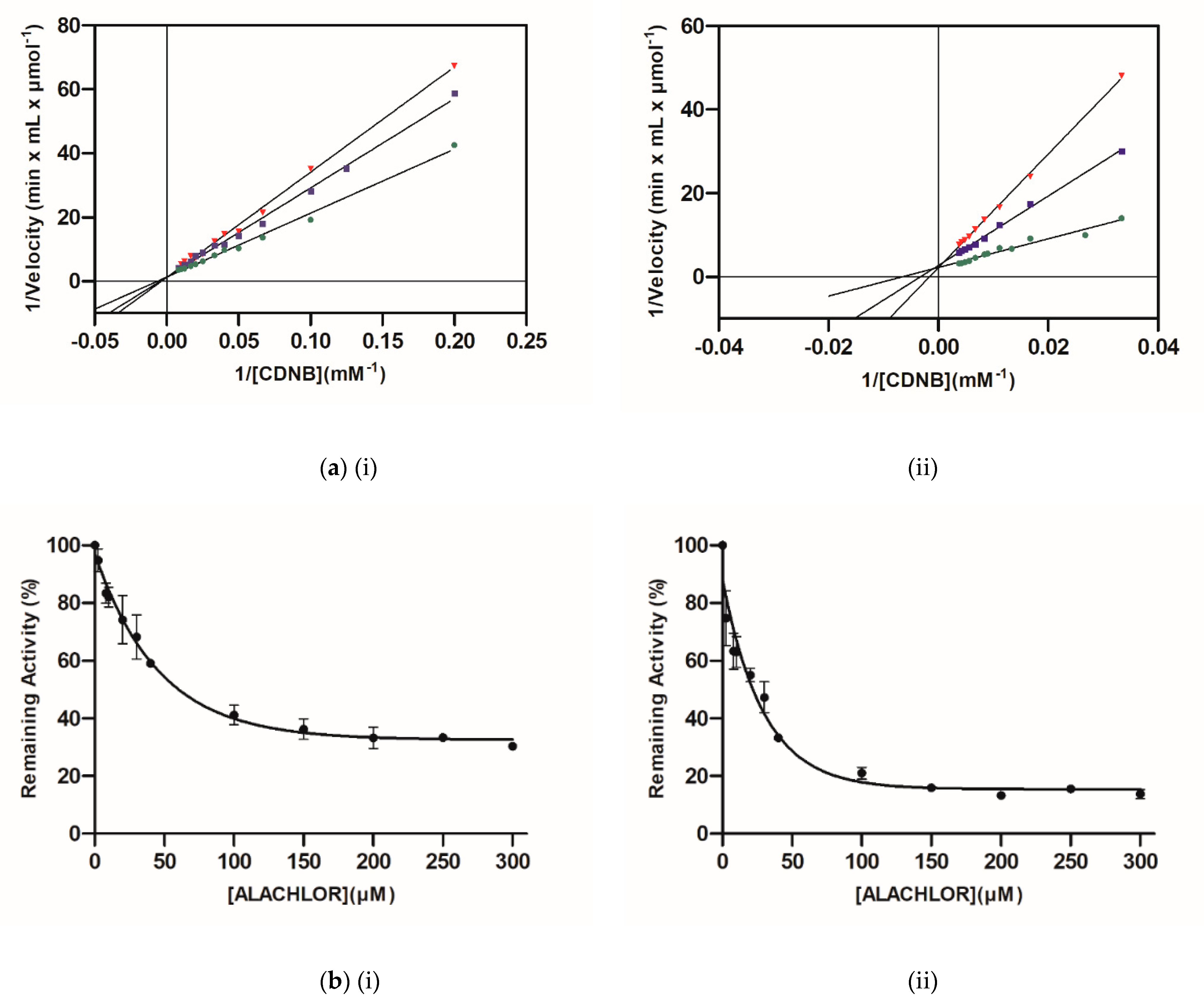
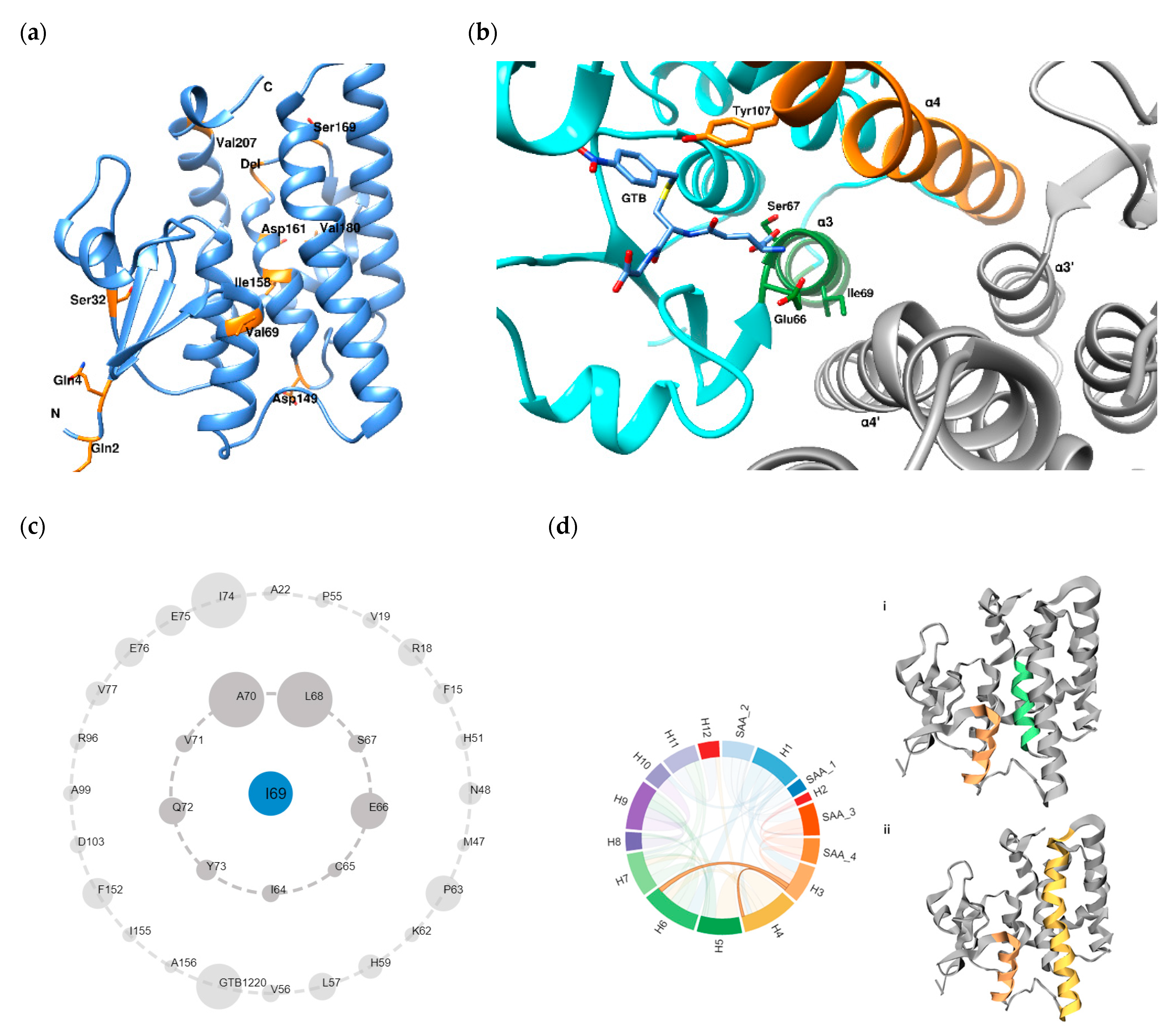
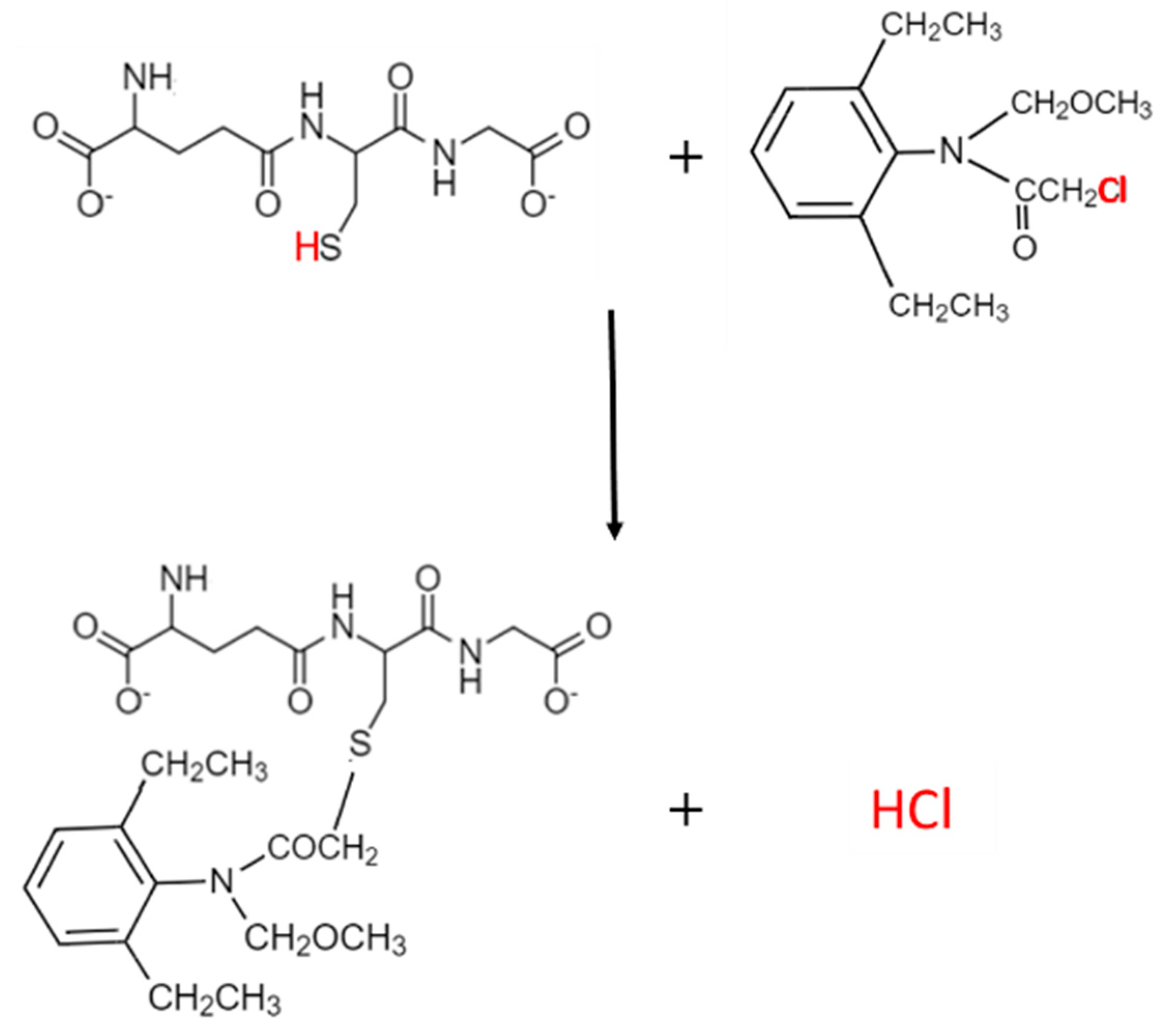
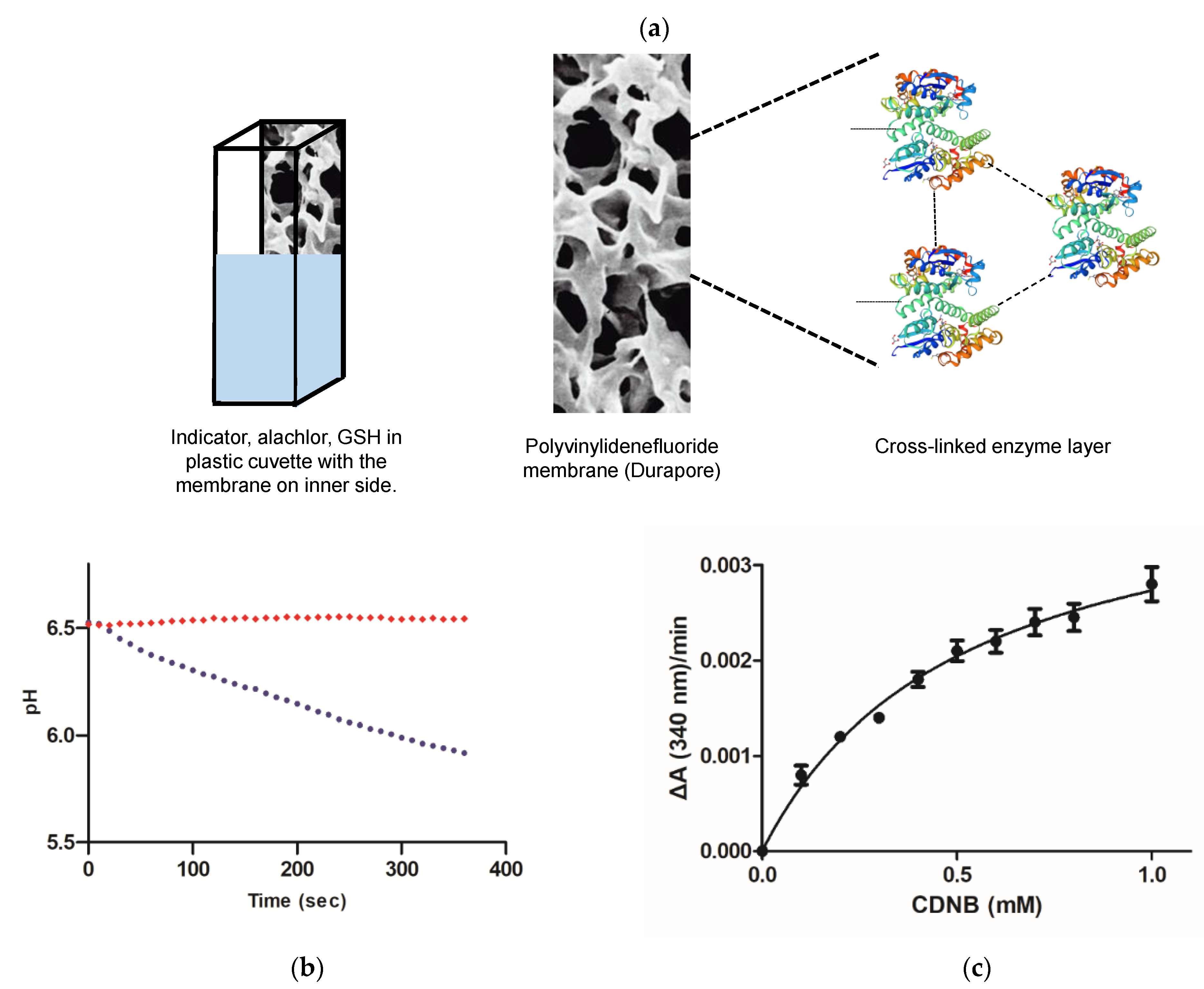
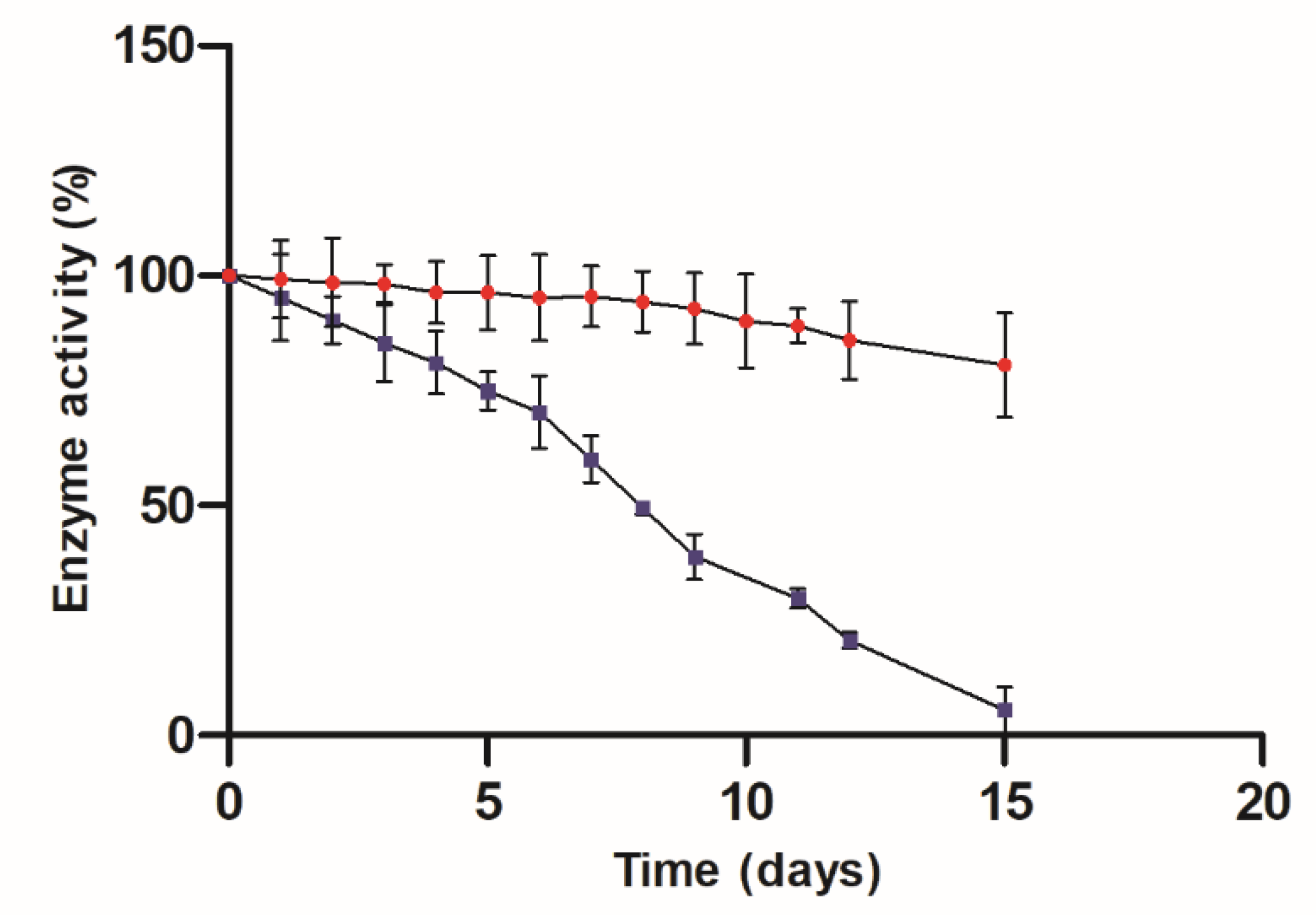

| GmGSTsf (Amino Acid Replacement in GmGSTU4-4 Sequence) | Source of Mutations |
|---|---|
| Ser2Gln | Spontaneous mutation |
| Glu4Gln | Spontaneous mutation |
| Tyr32Ser | GmGSTU2-2 |
| Ile69Val | GmGSTU2-2 |
| Asn149Asp | GmGSTU2-2 |
| Val158Ile | GmGSTU2-2 |
| Tyr161Asp | GmGSTU2-2 |
| Deletion (166AlaTyrGlu168) | GmGSTU2-2 |
| Thr172Ser | GmGSTU2-2 or GmGSTU10-10 |
| Ile183Val | GmGSTU2-2 or GmGSTU10-10 |
| Met210Val | GmGSTU10-10 |
| Enzyme | kcat (min−1) | Κm (μΜ)(GSH) | Κm (μΜ)(CDNB) | kcat/Κm(GSH)(min−1μM−1) | kcat/Κm(CDNB)(min−1μM−1) |
|---|---|---|---|---|---|
| GSH/CDNB | |||||
| GmGSTU4-4 1 | 149 ± 18.6 | 159 ± 18.9 | 158 ± 31.6 | 0.9 | 0.9 |
| GmGSTsf | 472 ± 42.6 | 223 ± 23.3 | 351 ± 48.1 | 2.1 | 1.3 |
| Enzyme | kcat (min−1) | Κm (μΜ)(GSH) | Κm (μΜ)(Alachlor) | kcat/Κm(GSH)(min−1μM−1) | kcat/Κm(CDNB)(min−1μM−1) |
| GSH/Alachlor | |||||
| GmGSTU4-4 | 4.5 | 210 | 225 | 0.021 | 0.020 |
| GmGSTsf | 15.2 | 319 | 352 | 0.047 | 0.043 |
| Enzyme | Ki (μΜ) | IC50 (μΜ) |
|---|---|---|
| GmGSTU4-4 | 127.3 ± 12 | 65.8 ± 11.8 |
| GmGSTsf | 7.5 ± 0.9 | 17.5 ± 5.2 |
| Type of Interaction | GmGSTU4-4 | GmGSTsf |
|---|---|---|
| Polar contacts | 4 | 3 |
| Weak polar contacts | 3 | 2 |
| Hydrogen bonds | 2 | 2 |
| Weak hydrogen bonds | 4 | 2 |
| Hydrophobic contacts | 11 | 6 |
| Added Alachlor Concentrations (mM) | Found Alachlor Concentrations (mM) | % |
|---|---|---|
| 0 0.02 | 0 0.019 | 100 95.0 |
| 0.04 | 0.037 | 92.5 |
| 0.08 | 0.084 | 105 |
| 0.10 | 0.09 | 90 |
| 0.17 | 0.19 | 111.8 |
Publisher’s Note: MDPI stays neutral with regard to jurisdictional claims in published maps and institutional affiliations. |
© 2021 by the authors. Licensee MDPI, Basel, Switzerland. This article is an open access article distributed under the terms and conditions of the Creative Commons Attribution (CC BY) license (http://creativecommons.org/licenses/by/4.0/).
Share and Cite
Perperopoulou, F.; Fragoulaki, M.; Papageorgiou, A.C.; Labrou, N.E. Directed Evolution of a Glutathione Transferase for the Development of a Biosensor for Alachlor Determination. Symmetry 2021, 13, 461. https://doi.org/10.3390/sym13030461
Perperopoulou F, Fragoulaki M, Papageorgiou AC, Labrou NE. Directed Evolution of a Glutathione Transferase for the Development of a Biosensor for Alachlor Determination. Symmetry. 2021; 13(3):461. https://doi.org/10.3390/sym13030461
Chicago/Turabian StylePerperopoulou, Fereniki, Maria Fragoulaki, Anastassios C. Papageorgiou, and Nikolaos E. Labrou. 2021. "Directed Evolution of a Glutathione Transferase for the Development of a Biosensor for Alachlor Determination" Symmetry 13, no. 3: 461. https://doi.org/10.3390/sym13030461
APA StylePerperopoulou, F., Fragoulaki, M., Papageorgiou, A. C., & Labrou, N. E. (2021). Directed Evolution of a Glutathione Transferase for the Development of a Biosensor for Alachlor Determination. Symmetry, 13(3), 461. https://doi.org/10.3390/sym13030461








